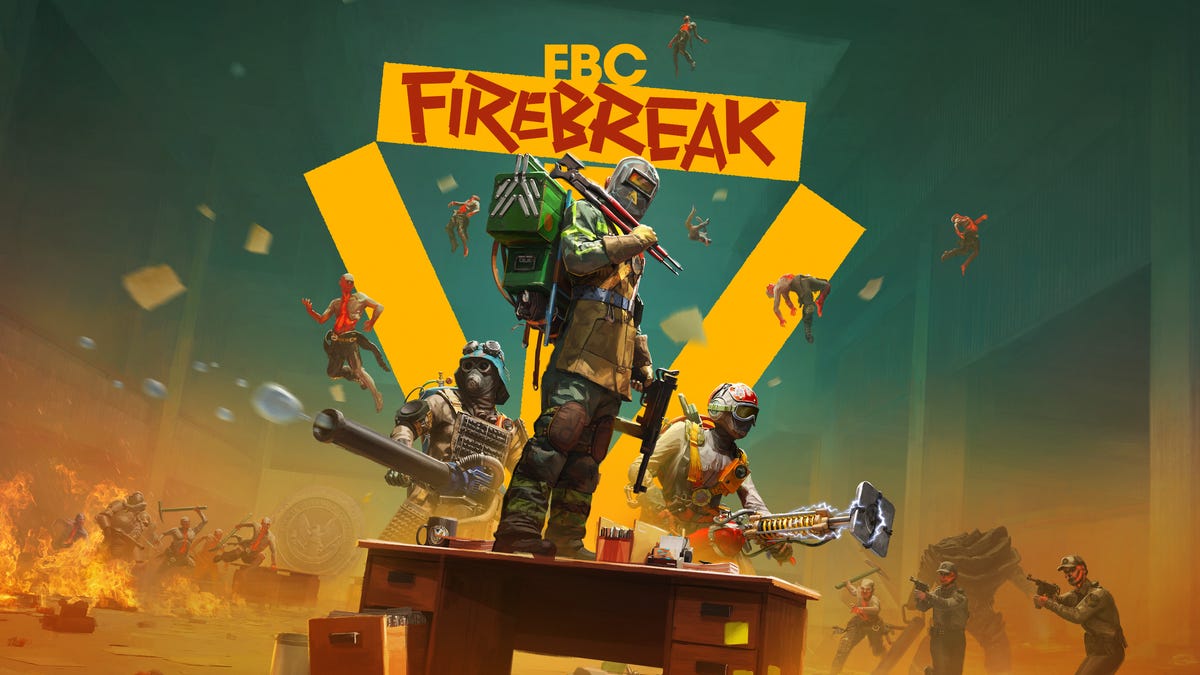Technologies
FBC Firebreak Hands-On: Saving the Office With Super Soakers and Shotguns
A preview for Remedy Entertainment’s squad shooter showed off its weird and fun co-op action, like Left 4 Dead meets Ghostbusters.

Minutes into my mission, I’m having second thoughts. Gunning down a dozen zombie-like enemies is a lot for a lowly office worker in the Federal Bureau of Control. At first, it’s hard to have faith in my gear — a backpack water jug with a cannon for drenching enemies. But then my fellow FBC squad mate (a secretary or middle manager, I forget which) uses his kit to zap all the soaked foes at once. With our third coworker slamming their wrench into anything that moves, we barely manage to fix up some broken fans before sprinting for the elevator as the doors close on the enemy horde.
Welcome to FBC Firebreak. Media got a chance to play the game for a few hours in an online preview ahead of its release on June 17.
Six in-game years after the events of Remedy Entertainment’s seminal 2019 game Control, the FBC headquarters is still partially occupied by the otherworldly Hiss invaders. But the brave workforce of the FBC has stepped up, and as one of the agency’s rangers or secretaries or middle managers, it’s up to players to drive them out of the offices.
FBC Firebeak is a departure for Remedy as its first game built to be multiplayer rather than its decades of single-player adventures. But the studio’s newest title is a smaller-scope «AA» game, unlike the flagship AAA releases like Alan Wake II, Control and its other prior hits. However, Firebreak’s $40 price tag (or $50 for the deluxe edition) that matches its more modest scope will be welcome to players reeling from the sticker shock of $80 games coming from Nintendo and Microsoft.
In my preview, I could see how Remedy is attempting to blend its signature style of weird, funky gunplay into a multiplayer setting, and mostly succeeds. There’s a lot of character to the world it’s built, and players will likely enjoy taking on the role of supernatural emergency responders as a change of pace from the gunplay-heavy squad shooters they know. But diehard fans of the studio’s storytelling-heavy approach will have to adjust to the new game’s fast co-op pace.
And they’ll have to get used to its difficulty, because FBC Firebreak is hard.
I’ll give you an example: My two squad mates — one of whom was CNET video editor Sean Booker — and I dropped into one of the three missions available to us. We each picked a gun and one of three equipment backpacks, each offering unique tools that work best when combined — a key way the game encourages teamwork. We set the mission to normal difficulty, and out we went.
The mission (or «job» in Firebreak talk) we chose was Paper Chase, wherein our squad is tasked with cleaning up a plague of supernatural Post-it notes. Like other areas of FBC headquarters, the offices we explored — faithfully recreated with ’60s shag rugs and retro decor from 2019’s Control — had been warped by the invading Hiss, making things even stranger. That meant we weren’t just fighting Hiss-possessed FBC workers clawing and shooting at us — we also had to gun down humanoid golems made of Post-its.
Our third squad mate dropped out due to GPU compatibility issues, so our CNET twosome cleared out gobs of Post-its haunting the office floor, all while getting slammed with unending hordes of enemies. We ran out of bullets pretty quickly. My colleague Booker had a mechanic’s kit with a mean wrench he could swing around — it also let him repair gadgets scattered around the level faster. Meanwhile, my backpack water blaster did little more than stagger enemies, relying on a one-two combo with the shock kit carried by our now-dropped-out squad mate.
With my weak melee and frequent deaths, Booker and I barely made it back to the elevator to finish the job. For the rest of our preview, we stuck to the easiest difficulty.
Squad up or die trying
Technically, you can drop into a «job» all by your lonesome, but I wouldn’t recommend it. They’re built to be challenging for three people, and I can attest how it’s a difficult enough experience with two, even on an easier setting. Four-person squads just weren’t balanced, as Remedy developers previously told me, which made sense as I fought tooth-and-nail through narrow hallways, roomy offices and spacious mines that would’ve felt crowded with more than two other teammates.
There are other tools at your disposal to take into jobs, like grenades, deployable equipment to use with your backpack kit and a rechargeable super ability (which we didn’t get far enough along to tinker with) — all gradually unlocked as you level up. Decked out in more gear, we stood a better chance of withstanding hordes of enemies. When I slammed down a jug filled by my water backpack that sprayed healing in a radius around it, we withstood waves of foes that had previously wiped us out.
But we still weren’t eager to tip the difficulty back up to normal, and how much players struggle may be a make-or-break point for Firebreak’s player experience. It’s a balance that could be tweaked in many ways before the game comes out in June, from enemy health and behavior to kit effectiveness and ammo availability. Remedy reinforced that the preview we saw was a work in progress, so I’d expect some tinkering to come, but the game walks a tricky line in encouraging (and borderline requiring) cooperation through its unique mechanics and tasks while allowing player flexibility — after all, the strangers filling your online co-op squad will come in a variety of skill levels and attitudes.
In its current state, getting swamped by wave after wave of Hiss while feeling my kit’s inadequacy is a bit worrisome. The game shows promise with its unique setting, gameplay and niche in the multiplayer shooter space — one that favors weirdness and intriguing mechanics over sweaty gunplay.
Co-op in the Alan Wake universe
As the FBC Firebreak developers explained in our briefing before the preview, the game was designed with three core pillars. The most obvious of those was on display when we booted up the game: there should be as little standing between players booting up the game and getting to the action. No cutscenes, plot diversions or dense dialogue to get in the way of jumping into a job.
That leads to the game’s second pillar: every player gets the same content — no progression roadblocks or paid DLC to split up a squad. For the $40 entry fee, players will get whatever the Firebreak developers introduce to the game — which at the moment are two additional jobs coming sometime after the game’s launch.
This ties into one of my main annoyances during the preview: progression felt too slow to unlock enough items that made me feel effective in the field. It makes sense if Remedy wants a longer progression runway to keep players coming back — for new equipment, better weapons and more cosmetics to outfit their Firebreak workers.
The last pillar was the one I saw the least of — mainly because we didn’t see much of the game: that FBC Firebreak delivers action and moments found «only in Control.» From the preview, this bore out in the reliance on kit equipment over guns — even without my third squad mate following up with an electricity blast, I discovered my water gun could stagger enemies when charged up, leaving my other squad mate to batter them with his wrench. This mixes in a dose of absurdity with the frenetic terror of Hiss hordes.
In practice, FBC Firebreak feels like a mixture of Left 4 Dead and Ghostbusters, which is a fun and funky blend that shakes up the tired squad shooter genre. But its focus on quickly moving players in and out of jobs leaves little room for the kind of secret-hunting and lore-digging that defined past Remedy games. To that end, it’s tough to imagine whether the studio’s diehard fans will embrace Firebreak’s loops running the same missions without heavy storytelling, let alone standout moments like Control’s Ashtray Maze or Alan Wake II’s We Sing musical sequence.
Firebreak’s developers previously told me they don’t believe those memorable moments really fit in a multiplayer game, especially if it means forcing players to relive them repeatedly. They’re probably right, but it means the new game will need to rely on emergent moments born from unpredictable, often ridiculous situations — the kind of had-to-be-there memories that help a game stand out.
With no more of FBC director Jesse Faden’s story until Control 2, and no required story content in Firebreak, the new game seems poised to truly stand on its own. And without any detail on how Firebreak ties into the greater Remedyverse storyline shared across the studio’s games, or how much lore it has tucked away waiting for players to discover, Firebreak will sink or swim based on how fun it is to run around as an office drone saving your workplace with wild gadgets and guns. A lot of that remains to be seen.
Technologies
Live-Action ‘Call of Duty’ Movie Reportedly Being Co-Written by Taylor Sheridan
The Yellowstone co-creator will reportedly team up with Peter Berg on the Paramount film.

Yellowstone, Landman and, now, Call of Duty. Taylor Sheridan, co-creator of the aforementioned hit shows, will co-write Paramount and Activision’s upcoming live-action video game adaptation, according to a report from Variety on Thursday.
Peter Berg will also co-write and direct the movie, which was announced last month. Berg previously directed films including 2018’s Mile 22, 2012’s Battleship and 2013’s Lone Survivor, while Sheridan’s movie credits include 2016’s Hell or High Water and 2017’s Wind River. Berg, Sheridan and David Glasser will produce the Call of Duty film.
Don’t miss any of our unbiased tech content and lab-based reviews. Add CNET as a preferred Google source.
Call of Duty is a first-person shooter military video game series that debuted in 2003. CNET senior writer David Lumb calls it «arguably the biggest shooter franchise in gaming, with millions of players picking up every year’s new entry to the series.»
Lumb said the franchise is known for its bombastic single-player campaigns, which feature globe-spanning plots that rival those of the Mission Impossible films. «A Call of Duty movie has a lot of material to draw from,» Lumb said.
He also noted that Berg’s direction of Lone Survivor would fit the grim military heroism of Call of Duty, while Taylor Sheridan’s spate of neo-Western films and shows could lend a frontier adventurism to the film.
«Their collective works seemingly harmonize with the jingoistic pro-military tune of Activision’s shooter franchise — which is probably a good thing for Call of Duty fans,» Lumb concluded.
A release announcing Paramount and Activision’s film deal teased that it’ll be «designed to thrill its massive global fan base by delivering on the hallmarks of what fans love about the iconic series, while boldly expanding the franchise to entirely new audiences.» It didn’t include cast or plot information.
The update follows recent news that Sheridan is leaving Paramount for NBCUniversal. Paramount did not immediately respond to a request for comment.
Technologies
US Government Urges Total Ban of Our Most Popular Wi-Fi Router
Technologies
Animal Crossing Update Adds Lego Furniture, With a Switch 2 Version Arriving the Same Day
Fans of Animal Crossing will have a reason to go back to their island.

Animal Crossing fans just received a big surprise, and it’s not just a new content update. A Switch 2 version is on its way.
Animal Crossing: New Horizons will receive its first big update in three years, according to a post from Nintendo on Thursday. The update, labeled 3.0, will roll out on Jan. 15, the same day the Switch 2 version of the game will be available for purchase.
Released for the original Switch back in 2020, New Horizons was the first Animal Crossing game to come to a Nintendo console since 2008’s Animal Crossing: City Folk for the Nintendo Wii.
Nintendo regularly updated New Horizons for two years after its release, but stopped at update 2.0.6 released in November 2022. Two updates were added earlier in the year to prepare the game for playability on the Switch 2.
Animal Crossing 3.0 Update
In the 3.0 update coming on Jan. 15, a new hotel is opening. Players can help bring in guests to stay at the hotel by decorating guest rooms and dressing up mannequins to sell resort clothing.
For those who haven’t touched New Horizons in years, a Reset Service will be available. Players can have their island cleaned up, and items can be stored away or trashed for those who want a clean slate.
Players with a Nintendo Switch Online membership will have access to up to three islands, where they can explore and do as they please. These new areas are available on Slumber Island. It’s up to the player to decide how the island will look, what items or plants are on it and even which characters will be found on the island. Players can also invite friends to build it together.
New Horizons will feature special collaborations and Nintendo retro gear. Lego items will be available in the update for players to decorate their homes with or clothing to dress up their villagers with. Retro Nintendo consoles, such as the NES and Game Boy, can also be used as decorative items.
If the player has a Switch Online subscription, some classic titles such as Ice Climbers and Dr. Mario can be played via these in-game devices. There are also special items based on The Legend of Zelda and Splatoon series when players tap their amiibo from those games onto the Switch while playing.
Animal Crossing: New Horizons on Switch 2
Switch 2 owners can get in on the digital life game with Animal Crossing: New Horizons — Nintendo Switch 2 Edition. Not only will this new version come with updated graphics, including 4K resolution in TV mode, but it will also add special features that can only be done on the newest console.
One of the features is mouse controls for the Joy-Con 2. Players will be able to use the controller as a mouse to decorate indoors, create custom designs and write handwritten messages for the bulletin board.
Residents in the game can now be found by saying their name into the Switch 2’s built-in microphone while using the megaphone in the game. Multiplayer has also improved dramatically, with 12-player sessions available for those playing on the new edition, and CameraPlay is supported to allow players to see one another.
Animal Crossing: New Horizons for the Nintendo Switch 2 will be available for purchase on Jan. 15 for $65. Owners of the original Switch version of New Horizons can upgrade to the Switch 2 version for $5.
-

 Technologies3 года ago
Technologies3 года agoTech Companies Need to Be Held Accountable for Security, Experts Say
-

 Technologies3 года ago
Technologies3 года agoBest Handheld Game Console in 2023
-

 Technologies3 года ago
Technologies3 года agoTighten Up Your VR Game With the Best Head Straps for Quest 2
-

 Technologies4 года ago
Technologies4 года agoVerum, Wickr and Threema: next generation secured messengers
-

 Technologies4 года ago
Technologies4 года agoBlack Friday 2021: The best deals on TVs, headphones, kitchenware, and more
-

 Technologies4 года ago
Technologies4 года agoGoogle to require vaccinations as Silicon Valley rethinks return-to-office policies
-

 Technologies4 года ago
Technologies4 года agoOlivia Harlan Dekker for Verum Messenger
-

 Technologies4 года ago
Technologies4 года agoiPhone 13 event: How to watch Apple’s big announcement tomorrow
